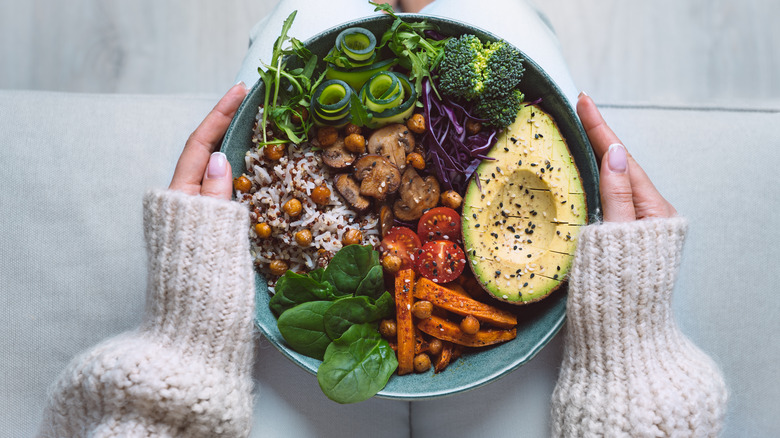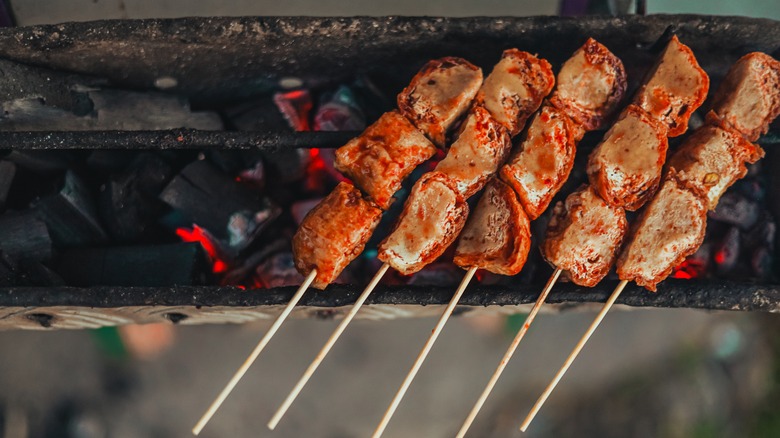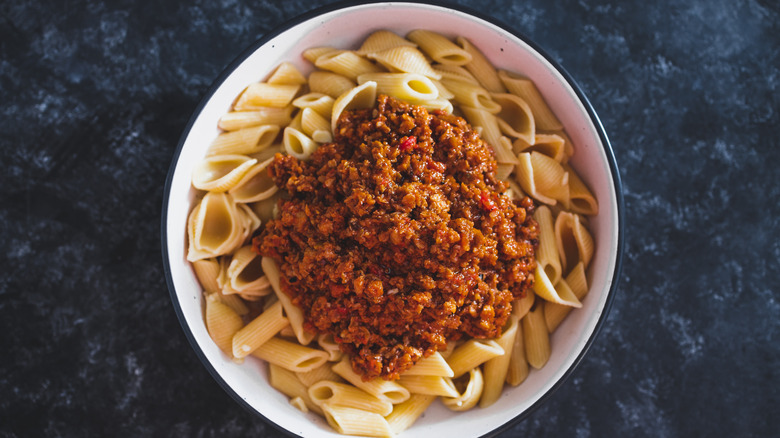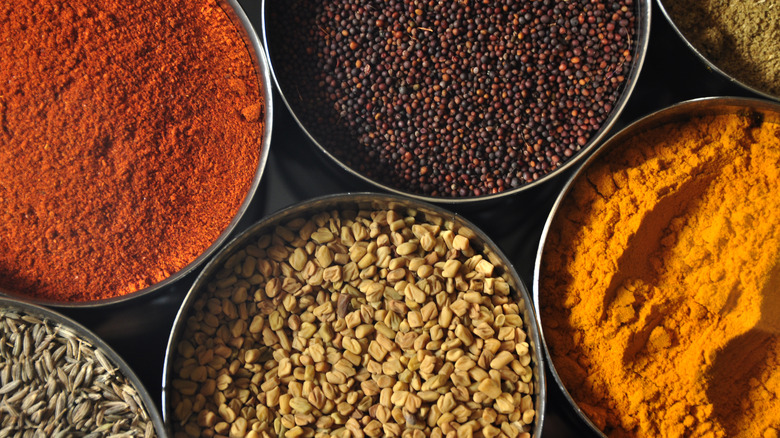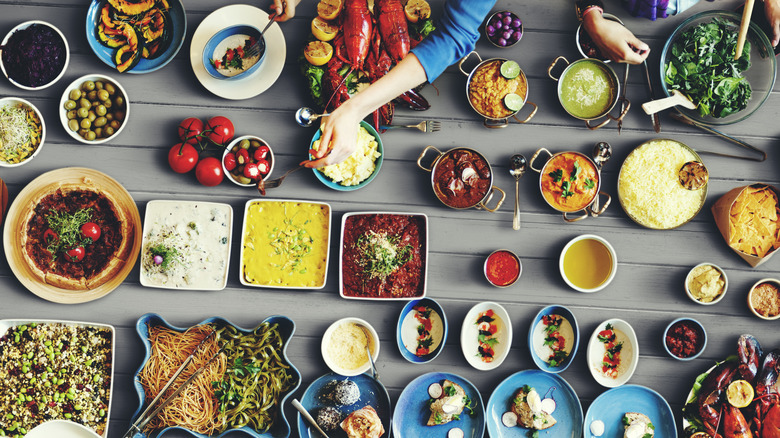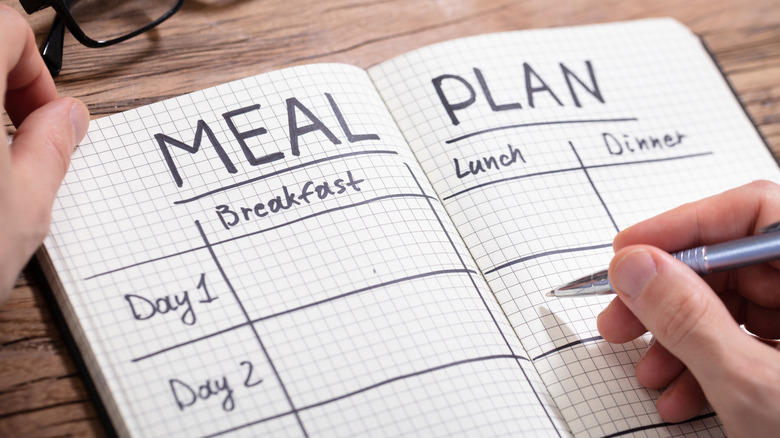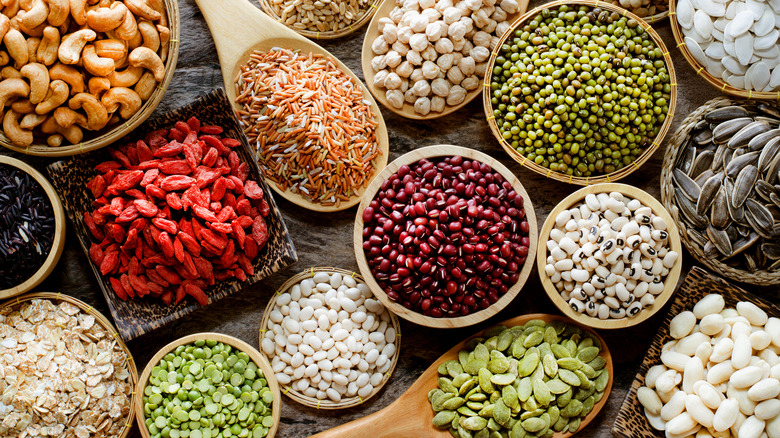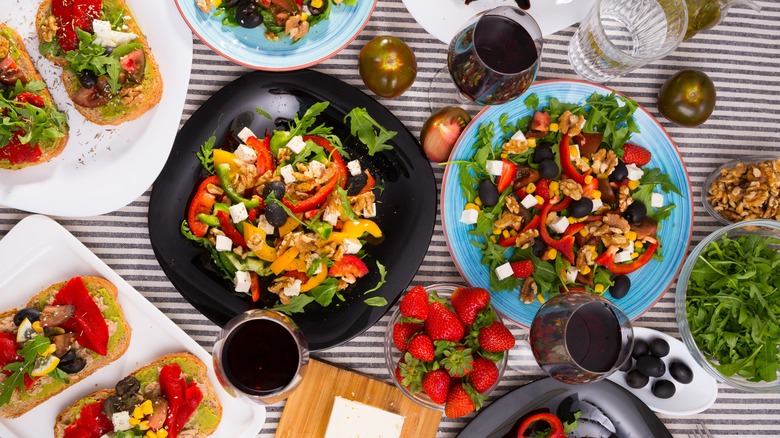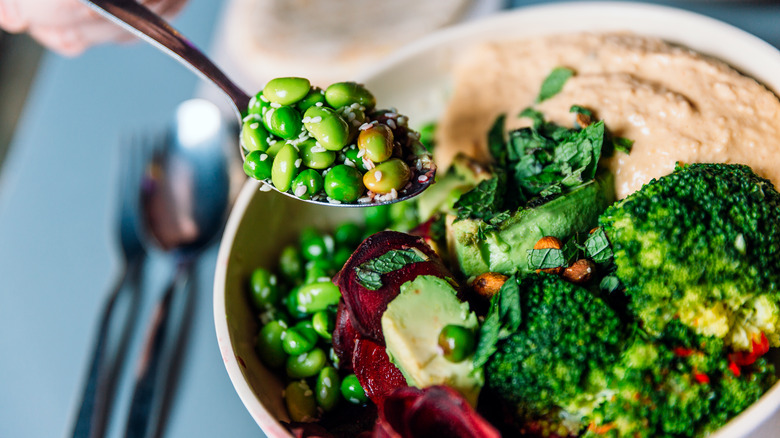12 Tips For Brand New Vegetarians
Chances are there's at least one vegetarian in your circle of friends and family, and knowing them probably made you wonder why they made the switch from the meat-loving standard. For some, it was no doubt an ethical decision; for others, a matter of nutrition. In certain cases, people simply lacked access to meat or found it too expensive to incorporate into their diets.
For those taking the leap from omnivore to a plant-based diet, the transition itself can be complicated and overwhelming. The newly-anointed vegetarian chef has years of experience working against them. Go-to meals — the staples of youth and beyond — take on a forever-denied status that is hard to shake. Adaptations and variations of animal based dishes sometimes fall flat as the realities of only using plant and dairy proteins begin to hit home. Thankfully, there are many ways that even an inexperienced vegetarian cook can elevate their game to a top-tier standard.
1. Get to know the basics
Basic cooking math is one of those things that people learn by osmosis. To create a meal, many start with a protein, add a vegetable, and throw in some starch or carbohydrates. For non-vegetarians, that protein is almost always meat or some kind of seafood. So, for most rookie vegetarian chefs, the first trick of the trade to master is figuring out your protein-based stars of the culinary show.
Plant-based proteins fall into several broad categories. First up are legumes, a classification that includes beans, certain nuts, lentils, and peas. Low in fat, they make an excellent base for curries, pasta dishes, and sides. Or, as is the case with miso and other soy-based products, added to pasta or soups for a burst of umami.
Next up are the meat alternatives. Smoked tofu adds savory elements to stir-fries, seitan adds texture to wraps, and Beyond Meat products chameleon their way into dishes as faux meats. Lastly come the vegetables themselves: diced eggplant, shredded zucchini, wild mushrooms, and roasted chilies often serve as the basis of meals in their own right. Learning to make the best use of these ingredients takes time, but is well worth the effort in the long run.
2. Remember old favorites
The idea that a newly converted vegetarian cook must start from scratch is something of a misnomer. After all, many popular dishes ranging from a good old slice of toast to a hearty tomato soup have always been vegetarian, if not vegan, friendly. Indeed, even the most ardent carnivore eats vegetarian food from time to time: mac and cheese, pancakes, or a tortilla Española, anyone? When searching for something to cook it's a great idea to remember those items you love that were always vegetarian.
Different meal times offer different options. Pancakes for breakfast, sans bacon, of course, are still on the menu, as is French toast, cereal, porridge and, depending on how strict you are, eggs. Lunchtime is rich with choices like sides of fries, flatbread and hummus, and pesto salads.
By the time dinner time rolls around, vegetarians and non-vegetarians alike are spoiled with options. You can whip up caramelized onion and tomato quiche, jacket potato with melted cheese, penne all'arrabbiata, and so much more. If you loved these meals before you made the switch to a plant-based diet, there's really no reason you can't lean on them as you explore your new reality. As you ease yourself into the vegetarian lifestyle, these favorites will make the transition more seamless.
3. Reinvent old favorites
Beyond the savored cacio e pepe or long-cherished falafel wrap, there's whole spectrum of recipes that traditionally contain meat, fish, or, if you are vegan, dairy. Thankfully, most of these meals are easily adapted to a range of dietary restrictions. Lentils can be slow-cooked into a magnificent ragù that works surprisingly well in meatless lasagna. Purees of squash or shreds of porcini mushrooms happily transform seafood risotto into something more compatible with your new diet. Black beans make excellent chili non-carne and caramelized carrots can help fill out tacos. And, Lightlife brand meatless bacon tossed into a vegetarian carbonara will make even the chef question if it's the real deal or not.
The point here is to experiment with the food you liked to eat before turning vegetarian. Burger lovers can learn to appreciate a veggie version of proven classics, those who crave a traditional shepherd's pie will soon discover workable alternatives, and carefully curated pizza toppings can make up for a lack of pepperoni. Such dishes alter the nutritional makeup of the food too as the cholesterol content of meat finds itself replaced with nutrient-rich vegetables.
4. Spices are your friend
The rich umami flavors found in meat and fish set them apart from other proteins. A steak, for example, is often cooked in little more than its own juices, seasoned, and served as is. There's absolutely a place for such simplicity in vegetarian cooking — after all, there's nothing wrong with a little steamed broccoli. Still, when it comes to the main event, there are times when you have to go the extra mile to extract as much flavor as you can. This is where the spice drawer comes in.
Spice is often confused with the notion of heat, with Scovilles raising the temperatures to eye-watering levels. There's a place for chiles in vegetarian cooking, to be sure, but there's also an entire world of subtler tastes to explore. There are combinations of exotic seeds, plants, and powders that help maximize that flavor punch.
Tarragon takes the earthiness of wild mushrooms to new heights. A sprinkling of Puerto Rican sazón transforms everything from roasted cauliflower to rice and beans. A squeeze of lime and a handful of chopped cilantro freshen up the heaviest of dishes, while mixing a little ginger, green onions, and soy sauce together creates the perfect dressing for pouring over tofu or used to marinate seitan. Once again, experimentation is of critical importance. Just as basil takes your typical Caprese salad to next-level greatness, other herbs and spices can elevate your vegetarian creations.
5. Explore the world
While a lot of meals focus on animal protein as the main attraction, there is a rich history of vegan and vegetarian food awaiting discovery. Throughout the world, certain regional cuisines have a focus on meat-free options. Indian, Thai, Indonesian, Japanese, and southern Italian cultures are all rich with such opportunities.
Some selections are no-brainers like the hummus of the Middle East, the sag paneer curries of the Indian subcontinent, and the myriad of Italian dishes that eschew meat as a point of tradition. Other delights require a little more thought. Over in Mexico, both tacos and tamales are great vehicles for meatless dishes. The salsa, chiles, guacamole, and other fresh ingredients are typically plant-based. Plus, you can incorporate a little smoked eggplant, fried tofu, or three-bean chili into the mix. A simple patatas bravas or tortilla espagnole acts as a launching pad for a spectacular tapas evening when paired with a rich and creamy moussaka.
In Asia, the eponymous pad Thai, stir-fried noodles with tofu, crushed peanuts, and a sweet and sour sauce, is commonly served without meat, while in Vietnam, pho often arrives with cubes of floating tofu. Even France gets in on the act, serving a variety of savory crêpes, cheese tarts, and of course, its world-famous ratatouille. Indeed, you can find vegetarian food in the most unlikely of places — all it takes is a little exploration.
6. Plan your meals
Meal planning brings both time-saving and financial benefits. It cuts down on waste by allowing you to use ingredients left over from one meal to the next. The versatility of vegetarian cooking makes it an excellent candidate for such culinary discipline.
Certain recipes require a little forward thought. You might need to soak some chickpeas overnight if you're going for a super authentic hummus, or, if eating out, check that the restaurant has some decent veggie options available. Of more importance is the need to prevent yourself from getting overwhelmed. If you're unfamiliar with vegetarian cooking, a poorly-researched trip to the supermarket might lead to a rookie mistake, and eventual food waste. While a fridge full of fresh produce is a satisfying sight, if you don't know what to do with all that leafy goodness, it might wind up in the trash.
The trick is to pair what you've bought with what you intend to make. A halved butternut squash or pumpkin might find itself the main attraction in a creamy coconut soup one night, leaving the other half to create a sagey puree to top a risotto. And, a well-stocked pantry is a must. Access to vegetarian staples like nutritional yeast, miso, and dried mushrooms creates a wealth of options that make planning out your week's meals less of a chore.
7. Know your lingo
It's easy enough to avoid eating a piece of meat when it is offered to you, but there are hidden dangers for the committed. Not all cheese is vegetarian, and certain condiments, such as Worcestershire sauce, are often made from fish or other animal products. Meanwhile, everyday items that you may assume are vegetarian, such as McDonald's fries, contain beef flavoring, at least in the U.S. market.
Everyone has a different line in the sand that they don't want to cross, and finding yours will help you navigate the waters of your first few months as a vegetarian. First, you'll need to decide what kind of vegetarian you are. Your typical pescatarian does not eat meat but is okay with seafood. Lacto-ovo vegetarians eschew meat and fish but still eat eggs and dairy. Lastly, vegans keep to an entirely plant-based diet.
Where you land on this spectrum dictates what you can and cannot eat. Fortunately, these days, many product labels show whether the food is suitable for specific diets. Restaurants, too, will often indicate whether certain menu items are vegan or vegetarian or, if not, some will offer to make something vegetarian or vegan on the fly for you.
8. Take nutrition into account
Vegetarianism is not a guaranteed path toward a more nutritious lifestyle. Many plant-based foods are high in sugars and saturated fats. The need to stay away from a mac and cheese diet might be an obvious one to consider, but there are additional pitfalls to avoid when it comes to vegetarianism.
According to the Mayo Clinic, vitamin B12 — essential for the production of red blood cells — is naturally found in animal products. However, vegans in particular have a hard time incorporating enough of it into their diet unless the turn to nutritional yeast, fortified food, or supplements. Omega-3 is another of those watchwords that vegetarians should pay attention to. Although walnuts, soy, and canola oil have this fatty acid, two specific types known as DHA and EPA are mainly found in fish. Vitamin supplements can help offset possible deficiencies.
Regardless, vegetarianism has no problem providing you with every other nutrient you can think of. Leafy greens are high in iron and zinc, vitamin D is present in sunshine and milk and often added to fortified cereal, milk, and yogurts. Calcium is present in dairy, and vegans can derive the mineral from soy, beans, and pulses. A multitude of fruits are rich in vitamin C, and the oft-overlooked iodine, essential for thyroid health, is present in seaweed, eggs, and green beans.
9. Don't obsess over protein
Monitoring your intake of specific nutrients is one thing, obsessing over them is quite another. When many people think of protein, their mind turns to meat. True, protein is found elsewhere: in cheese, nuts, and eggs, to name just a few, but its association with the meat industry remains strong nonetheless.
It's hardly a surprise, then, that newly anointed vegetarians sometimes find themselves at a loss as to how to replace what was previously their main source of protein. And yet, it might come as a surprise to learn that most people overindulge in this area and many meat-eaters consume much more that they need.Plus, a study published by the journal Nutrients demonstrates that, while vegetarians generally eat less protein than meat-eaters, they still consume more than the daily requirements. This is especially true for vegetarians that eat a wide variety of foods like legumes and seeds.
10. Try something new every week
We're told that variety is the spice of life and when it comes to cooking its an especially poignant notion. Vegetarians aren't alone when it comes to getting stuck in a culinary rut. Go-to meals that gel with busy schedules, become a revolving menu of the same midweek dishes. The need to manage nutrition adds a sense of urgency here, but at its heart, variety is as much about keeping things interesting as it is about health concerns.
Bookmarking vegetarian recipe pages is a great idea, as it allows you to pick new things at random, alphabetically, or as the season dictates. Experimentation is also a great idea. For example, does that kung pao tofu dish work with some roasted squash? How does that pesto pasta dish taste with sundried tomatoes added? There's only one way to find out. Either way, making sure you try something new at least once a week keeps things fresh. You'll likely discover some delicious meals to add to your repertoire.
11. Try it part-time
It's one thing to equip yourself with all the tools you need to make a serious lifestyle shift, but quite another to stick to it. Sudden cravings, lapses in judgment, and even moments where you forget that you're not supposed to be having meat gravy with your biscuits get in the way of what might otherwise be a clean slate. Of course, there are no strict rules to follow; vegetarianism is about self-determination, not a hierarchy of guilt. Taking things at your own pace is perfectly fine.
One way to do this is to ease yourself into the switch. Choosing specific times, such as weekdays or weekends, to stick to your new reality helps avoid some of the pitfalls of the change. Opting to only go veggie for specific meals, such as breakfast or dinner, is another way to smooth the transition. Others might try a week on, week off approach with the off weeks becoming less frequent as time goes on. Lastly, a tiered system in which you remove specific items, such as red meat, from your diet on a case-by-case basis works well for some.
Whatever method you choose, going part-time as a vegetarian allows you to prepare both mentally and physically at your own pace. Indeed, the staggered approach to vegetarianism is used by a lot of people. For example, the gradual transition from pescatarian to lacto-ovo vegetarian to all the way to true veganism is a common journey.
12. Remember to have fun
Whatever your reasons for becoming vegetarian, it's important to remember that the transition doesn't have to be a chore. You're allowed to slip up, and you're allowed to make mistakes. The goal is to make a change, and the method you use to make the adjustment is up to you. Those who lean into their new lifestyle by learning to cook new dishes are more likely to enjoy the transition than those who do not.
There is, after all, an entire world of new and exciting culinary creations for you to explore. A world of artichoke pizza, asparagus fritters, and charred corn soup to experiment with. New skills can be picked up along the way as you learn to whip aquafaba, twist tofu into bacon-tasting strips, and extract flavor from the simplest of ingredients. Having fun is the art of finding your comfort zone, relaxing into change, and learning to enjoy unfamiliar ingredients on your way to expertly-prepared veggie dishes.
